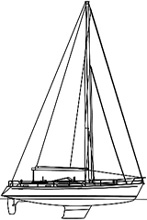Moody 54
Family cruiserr
The D/L of this design is 201 and that's on the light side for a boat of this type. Beam is moderate. Overhang forward is fashionably short. There are two keels offered, one with a 7-foot, 6-inch draft and another shoal keel that draws 5 feet, 11 inches. The hull shape looks reasonable although I have no lines plan. The deck plan forward looks full to my eye and that would be consistent with other Dixon designs. I like fine entries. This design has an attractive, gentle spring to its sheerline.
The rudder is a partially balanced spade on a short, partial skeg. This allows for a lower bearing for strength. This is an odd-shaped rudder blade. Note that the leading edge is almost vertical. I'm going to guess this was an attempt by the designer to get more balanced area forward of the rudder stock to relieve steering pressure.
Once you get the LOA into the mid-50s you get the volume you need for a spacious, three-stateroom boat. Unfortunately, the pressure to expand the accommodations falls on the fo'c'sle and lazarette. Both these utility areas have been reduced to the minimum.
This is a very nice accommodation plan. The galley looks good with counter space on each side of the range for pots and pans. The sinks could be moved aft a foot. The big, curved dinette looks roomy but I don't think you could seat more than four in comfort. Note the wet locker location and the handy sea berth in the passageway aft. I think the foot of the sea berth tucks into the aft cabin. Sleeping areas are roomy and have plenty of hanging locker space. The small stateroom forward has upper and lower berths and a small vanity. It's tight, but adequate. There is access from the forward stateroom to the head and shower. It would be nit-picking to find fault with this comfy layout.
Rig fashions come and go but the good old cutter rig seems to still be the cruiser's rig of choice. I should correct myself: A cutter is defined more by the mast location than the number of headsails. This rig is really a sloop with extra headsails. The staysail will be used for heavy air and reaching. There is a track just forward of the mast indicating that the staysail will be self-tacking. Note the swept spreaders combined with fore and aft lowers. I thought about using this type of staying arrangement on a recent design of my own but I decided the forward lower would only duplicate the vector provided by the swept spreaders so I went with single lowers.
The sail area-to-displacement ratio for this design is 16.49. This number is low by today's inflated ratios but where it should be for a yacht of this type. Remember that a big, powerful rig will be more demanding on the crew and the gear. Family-type cruising boats are better off with modest rigs and an SA/D between 16.5 and 19.
The deck is laid out with all halyards and lines led back to the cockpit. This means you will be able to unfurl the main from the cockpit. The windshield is a good feature. The swim step looks on the small side but any more area devoted to it would have to be subtracted from the lazarette and I'm not sure that would be a good trade-off.
This is a very "normal" cruising boat in every respect. There are no surprises and no novel features. It is obviously designed to have wide market appeal.

Comments